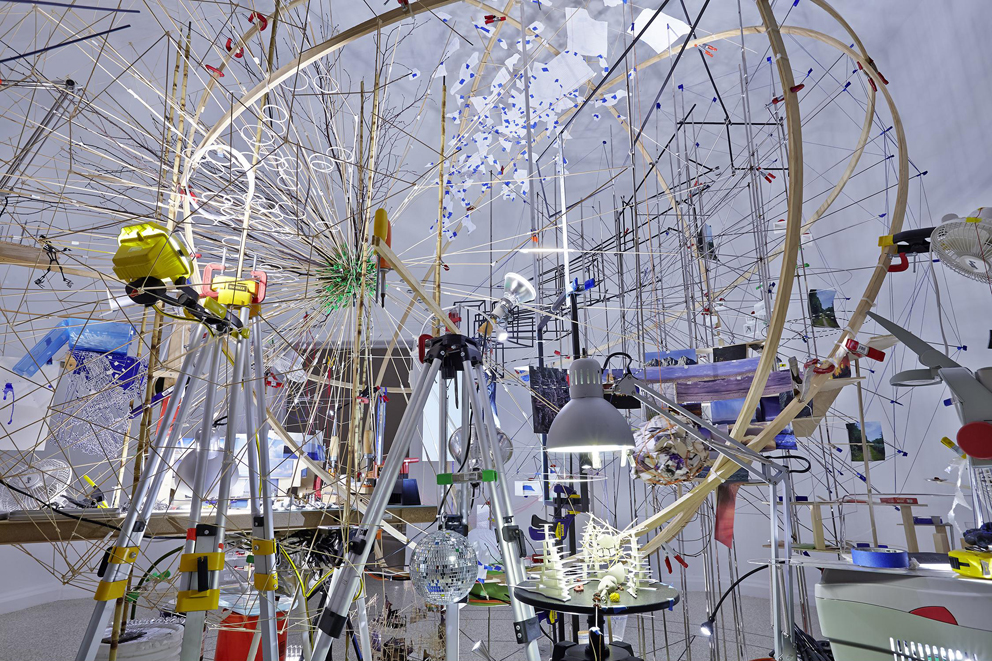11 September 2013
Andria was built so artfully that its every street follows a planet’s orbit, and the buildings and the places of community life repeat the order of the constellations and the position of the most luminous stars: Antares, Alpheratz, Capricorn, the Cepheids. The city’s calendar is so regulated that jobs and offices and ceremonies are arranged in a map corresponding to the firmament on that date: and thus the days on earth and the nights in the sky reflect each other.
Italo Calvino, Invisible Cities (chapter 9: Cities and the sky, 5)
In his painting entitled The Ancient of Days, William Blake depicts a powerful bearded man—a sort of pagan demiurge—crouching on the surface of the sun while measuring the exact curvature of the Earth with a pair of golden compasses. According to the myth recounted by Plato, the demiurge composed the universe out of cubes and tetrahedrons: he arranged, assembled and combined geometric shapes, like an infallible celestial engineer.
In a certain sense, Sarah Sze’s large installation in the US Pavilion displays a similar creative energy. The work of the American artist spreads through the rooms of the neo-Palladian building, occupying its corners and recesses and deconstructing the architecture of the place. A galaxy of disparate objects (leaves, stones, postcards, colored ribbons, bottles, books, drinking glasses) makes up a rich microcosm, delicate, chaotic and colorful. Far from the perfection of the undertaking of Blake’s demiurge, the multiple universe of Triple Point takes its inspiration (apparently) from the principle of causality rather than from a stubborn geometricism. It provides for gaps and defects, at the expense of the mathematical exactness of the whole. Sarah Sze reproduces a world that has been through a cosmic explosion: it is what is left of an ancient astral order.

Sarah Sze, Triple Point (Planetarium), 2013. Courtesy: Sarah Sze, Tanya Bonakdar Gallery (New York) and Victoria Miro Gallery (London). Photo: Tom Powel Imaging.
Walking through the rooms of the pavilion, you feel disoriented. The traditional entrance of the building—set in its classical façade of a pronaos with columns—is now inaccessible; the sculptures redefine the spaces, modifying the usual route of the visit. All criteria of rational order break down; the juxtaposition of objects appears accidental. And yet Sarah Sze’s labyrinthine works elude any postmodernist interpretation: the artist does not renounce grand narratives of the world, though well aware that they will be patchy and imperfect. Just like the fragile world of Triple Point.

Sarah Sze, Triple Point (Eclipse), 2013. Courtesy: Sarah Sze, Tanya Bonakdar Gallery (New York) and Victoria Miro Gallery (London). Photo: Tom Powel Imaging.
The title of the exhibition alludes to a concept of thermodynamics: the triple point is the situation in which the three different phases of a substance—its solid, liquid and gaseous states—coexist. It is a precarious equilibrium that is destined to break down; a sort of temporary set of samples of the various states that matter can assume. Triple Point recalls, in the arrangement of the objects, a kind of pseudo-scientific catalogue. It resembles a bizarre cabinet of curiosities, filled with objects of little value that compose weird galactic constellations. A subjective, incomplete and highly imaginative summa of the world. A visual equivalent of the Voyager Golden Record, the archive of sounds, images and words from Earth launched into space in 1977. Just like the latter, Sarah Sze’s work constitutes a curious inventory of our world—but one conceived for us, its inhabitants, rather than for forms of extraterrestrial life.

Sarah Sze. Photo: Suki Dhanda.

Sarah Sze, Triple Point (Pendulum), 2013. Courtesy: Sarah Sze, Tanya Bonakdar Gallery (New York) and Victoria Miro Gallery (London). Photo: Tom Powel Imaging.

Sarah Sze, Triple Point (Planetarium), 2013. Courtesy: Sarah Sze, Tanya Bonakdar Gallery (New York) and Victoria Miro Gallery (London). Photo: Tom Powel Imaging.
Follow Federico Florian on Google+, Facebook, Twitter.
By the same author:
ArtSlant Special Edition – Venice Biennale
Notes on ‘The Encyclopedic Palace’. A Venetian tour through the Biennale
The national pavilions. An artistic dérive from the material to the immaterial
The National Pavilions, Part II: Politics vs. Imagination
The Biennale collateral events: a few remarks around the stones of Venice